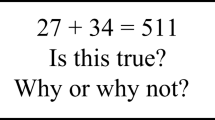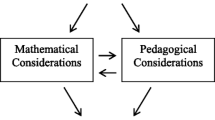Abstract
Insights into teachers’ planning of mathematics reported here were gathered as part of a broader project examining aspects of the implementation of the Australian curriculum in mathematics (and English). In particular, the responses of primary and secondary teachers to a survey of various aspects of decisions that inform their use of curriculum documents and assessment processes to plan their teaching are discussed. Teachers appear to have a clear idea of the overall topic as the focus of their planning, but they are less clear when asked to articulate the important ideas in that topic. While there is considerable diversity in the processes that teachers use for planning and in the ways that assessment information informs that planning, a consistent theme was that teachers make active decisions at all stages in the planning process. Teachers use a variety of assessment data in various ways, but these are not typically data extracted from external assessments. This research has important implications for those responsible for supporting teachers in the transition to the Australian Curriculum: Mathematics.

Similar content being viewed by others
Notes
This is a report of the Peopling Education Policy project that is funded by the Australian Research Council (LP110100062) with additional funding provided by the NSW Department of Education and Communities, Victorian Curriculum and Assessment Authority, Catholic Education Office Melbourne and the Australian Curriculum Assessment and Reporting Authority. The project is collaboration between Monash University, Australian Catholic University, University of Melbourne, University of Newcastle, University of Sydney, and University of Technology Sydney. The content is the responsibility of the authors and the views expressed do not necessarily represent the views of the universities or the partners.
References
ACARA (2012). Development of the Australian curriculum. Accessed Jan 2012 from http://www.acara.edu.au/verve/_resources/The_Shape_of_the_Australian_Curriculum_V3.pdf
Ball, S. J. (1997). Policy sociology and critical social research. British Educational Research Journal, 23, 257–274.
Braun, A., Maguire, M., & Ball, S. J. (2011). Policy enactments in the UK secondary school: examining policy, practice and school positioning. Journal of Educational Policy, 25(4), 547–560.
Choppin, J. M. (2009). Curriculum-content knowledge: teacher learning from successive enactments of a standards-based mathematics curriculum. Curriculum Inquiry, 39(2), 287–320.
Clark, C. M., & Peterson, P. L. (1986). Teachers’ thought processes. In M. C. Wittrock (Ed.), Handbook of research on teaching (pp. 255–296). New York: Macmillan.
Clements, D. H. (2006). Curriculum research: toward a framework for ‘research-based curricula’. Journal of Research in Mathematics, 38, 35–70.
Drake, C., & Sherin, M. G. (2006). Practicing change: curriculum adaptation in the context of mathematics education reform. Curriculum Inquiry, 36(2), 153–187.
Fernandez, C., & Cannon, J. (2005). What Japanese and U.S. teachers think about when constructing mathematics lessons: A preliminary investigation. The Elementary School Journal, 105(5), 481–498.
Freebody, P., & Muspratt, S. (2008). Uses and effects of The Le@rning Federation’s learning objects: An experimental and observational study. Ministerial Council on Education, Employment, Training and Youth Affairs (MCEETYA), (p. 108), [at http://www.thelearningfederation.edu.au/tlf2/showMe.asp?nodeID=891]
Hamilton, M. (2009). Putting words in their mouths: The alignment of identities with system goals through the use of Individual Learning Plans. British Educational Research Journal, 35, (2), 221–242.
Harris-Hart, C. (2009). Performing curriculum: exploring the role of teachers and teacher educators. Curriculum Inquiry, 39(1), 111–123.
Hattie, J., & Timperley, H. (2007). The power of feedback. Review of Educational Research, 77(1), 81–112.
Heinmans, S. (2011). Education policy, practice and power. Educational Policy (pre-print March 14), 1–25.
Hill, H., Ball, D., & Schilling, S. (2008). Unpacking pedagogical content knowledge: conceptualising and measuring teachers’ topic-specific knowledge of students. Journal for Research in Mathematics Education, 39, 372–400.
Holmqvist, M., & Wennås Brante, E. (2011). What is discerned in teachers’ expressions about planning? Education Inquiry, 2(3), 497–514.
Keitel, C., & Kilpatrick, J. (1999). The rationality and irrationality of international comparative studies. In G. Kaiser, E. Luna, & I. Huntley (Eds.), International comparisons in mathematics education (pp. 241–256). London: Falmer Press.
Kilpatrick, J., Swafford, J., & Findell, B. (Eds.). (2001). Adding it up: Helping children learn mathematics. Washington, DC: National Academy Press.
Jin, X. (2012). Chinese middle school mathematics teachers’ practices and perspectives viewed through a Western lens. Monash University: Unpublished PhD.
Levinson, B. A., Sutton, U. M., & Winstead, T. (2009). Educational policy as a practice of power: theoretical tools, ethnographic methods, democratic options. Educational Policy, 23(6), 767–795.
Remillard, J. T. (2005). Examining key concepts in research on teachers’ use of mathematics curricula. Review of Educational Research, 75(2), 211–246.
Remillard, J., Herbel-Eisenmann, B. A., & Lloyd, G. M. (Eds.). (2009). Mathematics teachers at work: Connecting curriculum materials and classroom instruction. New York: Routledge.
Sherin, M. G., & Drake, C. (2009). Curriculum strategy framework: investigating patterns in teachers’ use of reform-based elementary mathematics curriculum. Journal of Curriculum Studies, 41(4), 467–500.
Shulman, L. S. (1986). Those who understand: knowledge growth in teaching. Educational Researcher, 15(2), 4–14.
Stein, M. K., Grover, B. W., & Henningsen, M. (1996). Building student capacity for mathematical thinking and reasoning: an analysis of mathematical tasks used in reform classrooms. American Educational Research Journal, 33(2), 455–488.
Superfine, A. C. (2008). Planning for mathematics instruction: a model of experienced teachers’ planning processes in the context of a reform mathematics curriculum. The Mathematics Educator, 18(2), 11–22.
Thorsten, M. (2000). Once upon a TIMSS: American and Japanese narrations of the Third international mathematics and science study. Education and Society, 18(3), 45–76.
Yates, L., & Grumet, M. (2011). Curriculum in today’s world: configuring knowledge, identities, work and politics. In L. Yates & M. Grumet (Eds.), World Yearbook of Education 2011—Curriculum in today’s world: Configuring knowledge, identities, work and politics (pp. 3–14). London & New York: Routledge.
Author information
Authors and Affiliations
Corresponding author
Rights and permissions
About this article
Cite this article
Sullivan, P., Clarke, D.J., Clarke, D.M. et al. Processes and priorities in planning mathematics teaching. Math Ed Res J 25, 457–480 (2013). https://doi.org/10.1007/s13394-012-0066-z
Received:
Revised:
Accepted:
Published:
Issue Date:
DOI: https://doi.org/10.1007/s13394-012-0066-z




